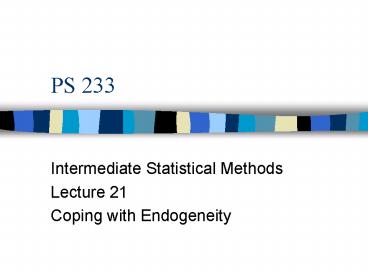PS 233 - PowerPoint PPT Presentation
1 / 19
Title:
PS 233
Description:
First, define and measure observations so as to avoid endogeneity ... We create an 'instrumental' measure of Y2 that is purged of its relationship to e2 ... – PowerPoint PPT presentation
Number of Views:33
Avg rating:3.0/5.0
Title: PS 233
1
PS 233
- Intermediate Statistical Methods
- Lecture 21
- Coping with Endogeneity
2
Pervasive Endogeneity Problems
- Endogeneity is one of most pervasive problems in
social science research - Fundamental problem is the lack of experimental
data - Causes can almost always be effects
- Most common response is to ignore this problem
- We can do better than that!
3
Examples of Ignored Endogeneity
- Trade is a cause of international peace
- ORstates trade if they anticipate peace
- Democracy causes economic growth
- OReconomic growth causes democracy
- Campaign money causes candidates to win elections
- ORdonations go to anticipated winners
4
Why Is Endogeneity a Problem?
- We have equation YXBe
- We observe covariation between X and Y
- We attribute this covariation to B the impact
of X on Y
X
B
Y
5
The Causal Indeterminacy of Covariation
- But if Y may also be a cause of X, how are we to
assess the overlap of X and Y - Should covariation be attributed to B, or a
second coefficient C reflecting the impact of Y
on X?
X
Y
C/B
6
Imagining a System of Equations
- Now to describe our theory we need a system of
two or more equations - Y1 and Y2 are endogenous variables in this
system and X1-X3 are exogenous
7
The Consequences of Ignoring the System
- What happens if we treat these equations as if
they were not related? - Estimate bs for first equation
- Y2 is not fixed, it is a function of e2
- Thus we create omitted variable bias
8
Showing b is Biased
- Lets examine what b is if we ignore our system
of equations - YXbe1, where b(XX)1XY
9
Showing b is Biased
- But we know that X is also a cause of Y
- That is, XYce2
- Thus unless cov(e1,e2)0,
- Thus the expectation of b remains
10
The Sources of Endogeneity Bias
- Thus the size and direction of endogeneity bias
is a function of the covariance between e1 and e2 - IF X causes Y and Y also causes X, but the error
terms are not correlated across these equations,
we can analyze the equations separately - BUTthis scenario is quite unlikely
11
When Do We Estimate Endogenity?An Example from
Public Opinion
Demographics (Age, Race, Gender)
Party Identification
Education
Tolerance For Casualties
US Right to Attack
US Will Succeed
12
Solutions to Endogeneity Bias
- There are two major strategies for coping with
endogeneity - First, define and measure observations so as to
avoid endogeneity - Specify the endogenous system and account for the
covariance of e1 and e2 in the estimation - Today well focus on first strategy
13
Do Experimental Research
- Endogeneity bias illustrates one of the great
strengths of experimental research - Think about whether your causal mechanism could
be addressed through experiments - Could be used in combination with other types of
real world data
14
Reconceptualize the Dependent Variable
- Is part of the dependent variable NOT a cause of
any independent variables? - Example Coercive success and crisis outcomes
- Select aspect of Y that is temporally subsequent
to X - It falls to researcher to identify what are
possible causes and possible effects
15
Reconceptualize the Independent Variables
- Similar strategy may work with regard to the
independent variables - Fundamental strategy is to disagregate data
narrow unit of observation - Is there some aspect of X that cannot be a
consequence of Y? - Again, it falls to the researcher to identify
possible causes and effects
16
Select Cases without Endogeneity Problems
- Identify cases where exogenous shock alters the
values of X - Example Redistricting and the incumbency
advantage - This is the quasi-experiment method
- Key problem ensuring the shock is really
exogenous
17
The False Hope of Lagged Variables
- May try to resolve problem with a simple lagging
of X variables - Relies on temporal requirements of causality
- Not very effective with time-series data
- Temporal correlations among data mean that et-1
(or et-5) are likely to be correlated with et
18
The Instrumental Variables Approach
- Alternative is to try to address the system of
equations explicitly - To estimate our first equation with the bs
unbiased, we need an estimate of Y2 that is
independent of e2
19
The Instrumental Variables Approach
- We create an instrumental measure of Y2 that is
purged of its relationship to e2 - Then we can insert this instrumental measure into
the first equation and proceed to estimate - More on this solution next time!

